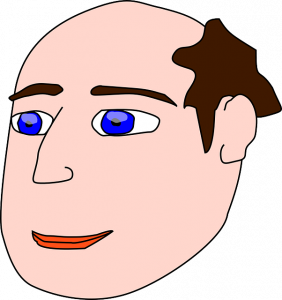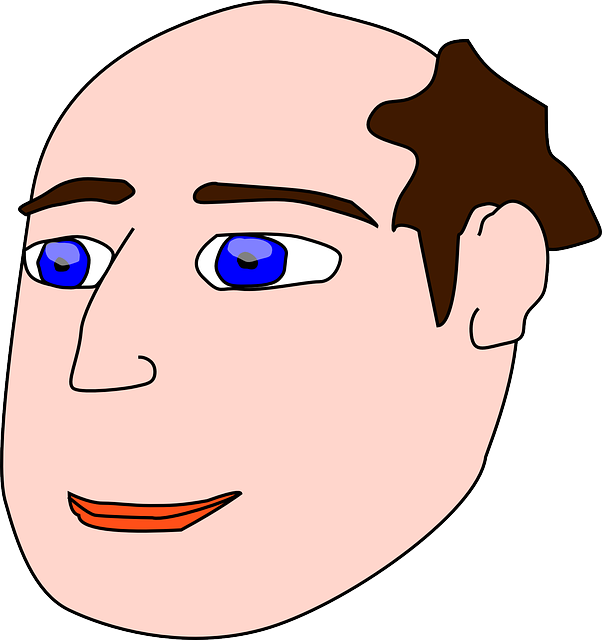Many people experience anxiety about their hairline, and it’s natural to wonder whether or not you are experiencing hair loss.
In this article, we will explore the signs of receding hairlines and provide some insight on how to determine if your hair is receding or if you are simply paranoid.
Firstly, it’s important to understand what a receding hairline is. A receding hairline typically occurs when the hair at the front of the scalp begins to thin out, creating a V-shape pattern. This can be caused by a variety of factors such as genetics, aging, hormonal imbalances, poor nutrition or stress.
However, it’s important to note that not all thinning at the front of your scalp indicates a receding hairline – sometimes hairstyles can make your forehead appear larger or expose more scalp than usual. Hence, in this article we will outline some of the key signs to look out for when trying to determine whether you are experiencing an actual receding hairline or just overthinking things.
Understanding Receding Hairlines
 Receding hairlines are a common concern for both men and women. It can be caused by several factors such as genetics, aging, hormonal changes, and certain medical conditions.
Receding hairlines are a common concern for both men and women. It can be caused by several factors such as genetics, aging, hormonal changes, and certain medical conditions.
If you are experiencing hair loss at your hairline, it is important to understand what is causing it and what treatment options are available.
Hairline treatments range from topical solutions to surgical procedures. Topical solutions like minoxidil can help slow down or even reverse hair loss in some cases. This medication works by increasing blood flow to the hair follicles and stimulating hair growth. However, it may take several months of consistent use before seeing results.
Another option for hairline restoration is hair transplantation surgery. This procedure involves taking hair follicles from areas of the scalp with strong hair growth and transplanting them to the thinning or balding areas. This technique has become increasingly popular in recent years due to its effectiveness and natural-looking results.
It’s important to note that not all cases of receding hairlines require treatment. For some individuals, a receding hairline may simply be a natural part of the aging process and not something that needs to be addressed.
However, if you are concerned about your hairline or experiencing significant hair loss, it’s best to consult with a dermatologist or trichologist who specializes in treating hair loss.
Remember that there are many different options available for those looking to restore their hairline. From topical solutions to surgical procedures, there is likely a treatment option that will work for you. It’s important to do your research and speak with a qualified professional before deciding on any course of treatment for your receding hairline.
Signs Of Hairline Recession
Hairline recession is a common issue that many people face. It is characterized by a gradual thinning of the hairline, resulting in a more prominent forehead. The signs of hairline recession can be subtle, and you may not notice them at first. However, if you do suspect that your hairline is receding, it’s important to take action.
One of the most significant signs of hairline recession is a receding hairline. This can be seen as the front of your hairline gradually moving back from your forehead. Other signs include a widening part, more visible scalp when your hair is pulled back or styled, and an overall thinning of the hair in the affected area.
To prevent further hairline recession, there are several things you can do. Firstly, avoid hairstyles that pull on your hairline, such as tight ponytails or braids. Secondly, protect your scalp from the sun with a hat or sunscreen. Thirdly, practice good nutrition by eating foods that contain vitamins and minerals that promote healthy hair growth.
If you are already experiencing hairline recession, there are several treatment options available to help restore your hairline. One popular treatment option is minoxidil, which is applied topically to encourage new hair growth. Another option is finasteride, which works by blocking DHT (dihydrotestosterone), a hormone that contributes to male pattern baldness.
Remember that early detection and prevention are key when it comes to dealing with hair loss issues like hairline recession. By following these tips and seeking professional advice when necessary, you can take control of your situation and maintain healthy-looking locks for years to come!
Factors That Contribute To Hair Loss
Hair loss is a common condition that affects both men and women, and there are many factors that contribute to it.
One of the most significant contributors to hair loss is genetics. If your family has a history of hair loss, it’s likely that you’ll experience it too.
Hormones also play a role in hair loss, particularly for men who have higher levels of testosterone. This hormone can cause the hair follicles to shrink, leading to thinning hair.
Another factor that contributes to hair loss is stress. High levels of stress can disrupt the natural growth cycle of your hair, leading to shedding and even baldness in some cases. It’s important to manage stress through relaxation techniques such as meditation or yoga, or by engaging in physical activities like swimming or running.
Poor nutrition is another factor that contributes to hair loss. Your body requires certain vitamins and minerals for healthy hair growth, including vitamin C, iron, and biotin. If you’re not getting enough of these nutrients through your diet, your hair may suffer as a result. To prevent this from happening, make sure you’re eating a balanced diet with plenty of fruits and vegetables.
Finally, if you’re experiencing severe or persistent hair loss despite making lifestyle changes or using over-the-counter treatments, you may want to consider a more advanced solution such as hair transplant surgery. This procedure involves taking healthy hair follicles from one part of your scalp and transplanting them into areas where you’re experiencing thinning or baldness. While it’s not suitable for everyone and can be costly, it can be an effective way to restore fuller, thicker-looking hair.
Remember: Prevention is key when it comes to dealing with hair loss. By maintaining a healthy lifestyle and managing stress levels effectively, you can reduce your risk of losing your beautiful locks prematurely!
How To Assess Your Hairline
Now that we’ve discussed the various factors that contribute to hair loss, it’s time to turn our attention to assessing your hairline.
It’s natural to be concerned about changes in your hairline, but it’s important to remember that not all changes indicate receding or balding.
Firstly, let’s talk about how to assess your hairline.
Start by examining your forehead in a well-lit area.
If you notice a slight recession of the hairline or widening of the part, don’t panic just yet – this can be a normal part of aging for many individuals.
However, if you notice significant thinning or a receding hairline that extends beyond the temples, it may be time to consider seeking professional advice.
When assessing your hairline, it’s also important to take into account any family history of hair loss.
Genetics can play a significant role in determining whether you are at risk for pattern baldness or other types of alopecia.
If you have a family history of hair loss, it’s essential to be proactive with your haircare routine and seek out preventative options sooner rather than later.
If you do find yourself experiencing significant hair loss or thinning, there are several options available for hair restoration.
From medications like minoxidil and finasteride to surgical procedures like follicular unit transplant (FUT) and follicular unit extraction (FUE), there are solutions available catered specifically for your needs.
Additionally, incorporating healthy habits into your daily routine such as regular exercise and a balanced diet can also help support healthy hair growth.
Remember, assessing changes in your hairline is something that should be done regularly as part of an overall self-care routine.
By staying informed on the latest haircare tips and restoration options available, you can take control of your own health and maintain healthy locks for years to come.
Coping With Hair Loss Anxiety
Managing anxiety around hair loss can be a challenging task, especially when it comes to the delicate issue of hairline recession. It’s not uncommon for individuals to experience feelings of paranoia and self-doubt when they begin to notice changes in their hairline.
However, it’s important to remember that hair loss is a common condition that affects millions of people worldwide.
One way to manage anxiety around hair loss is to seek professional help. A dermatologist or trichologist can provide valuable insight into the causes of your hair loss and recommend appropriate treatments. Additionally, talking with a mental health professional or support group can help you process your emotions and develop coping strategies.
It’s also important to keep in mind that hair loss is often a gradual process and not something that happens overnight. Monitoring changes in your hairline over time can help you better understand the extent of your condition and make informed decisions about potential treatment options.
In conclusion, managing anxiety around hair loss requires a multifaceted approach that addresses both the physical and emotional aspects of the condition. By seeking professional help, monitoring changes over time, and developing effective coping strategies, individuals experiencing hairline recession can take control of their situation and find peace of mind.
Frequently Asked Questions
Is Hairline Recession Only A Problem For Men, Or Can Women Experience It Too?
I often get asked if hairline recession is only a problem for men. The truth is that women can experience it too, albeit less frequently.
The causes of hairline recession in women vary from hormonal imbalances to genetics and lifestyle factors such as stress and diet. Unlike in men, hairline recession in women tends to be more diffuse and gradual, making it harder to detect at first.
However, early intervention is crucial to prevent further hair loss and promote regrowth. Some effective treatments for hairline recession in women include topical minoxidil, oral supplements like biotin and iron, and low-level laser therapy.
By understanding the gender differences in hairline recession experiences and seeking professional advice, both men and women can take control of their hair health and restore their confidence. Remember that your hair is not just a physical feature but also an expression of your identity and personality – so don’t let anyone or anything make you feel less than beautiful!
Can Certain Hairstyles Make Hairline Recession Worse?
Certain hairstyles can indeed make hairline recession worse. The worst hairstyles include tight braids, ponytails, and buns, which put excessive tension on the hairline and lead to traction alopecia.
Additionally, using heat styling tools like straighteners or curling irons too often can damage the hair follicles and contribute to hair loss.
It’s important to incorporate a healthy haircare routine that includes gentle brushing, regular trims, and nourishing treatments.
If you’re noticing signs of hairline recession, it’s best to consult with a hair loss expert or dermatologist for personalized advice on how to prevent further damage and promote regrowth.
Can Hairline Recession Be Reversed Or Stopped Once It Starts?
Hairline recession can be a sensitive topic for many people, and understandably so. But don’t let it bring you down! There are options available to help reverse or stop the process once it starts.
Hair transplant procedures can restore hair in the affected areas, while scalp micropigmentation can create the illusion of a fuller hairline.
I highly recommend consulting with a professional to determine the best course of action for your specific needs. Remember, there’s no need to feel self-conscious about your hairline – take control and explore your options!
How Long Does It Typically Take For Hairline Recession To Become Noticeable?
Hairline recession can be caused by a number of factors, including genetics, hormonal changes, and certain medical conditions. While it is not always preventable, there are measures that can be taken to slow down or stop the process.
These may include maintaining a healthy diet, reducing stress levels, and avoiding harsh hair styling products or treatments. It typically takes several months to a year for hairline recession to become noticeable, but this can vary based on individual factors such as hair growth rate and thickness.
It is important to educate clients on the potential causes of hairline recession and provide them with preventative measures they can take to minimize its effects.
Are There Any Supplements Or Vitamins That Can Help Prevent Or Slow Down Hairline Recession?
I can tell you that there are several supplements and vitamins that may help prevent or slow down hairline recession.
Biotin is often recommended for its ability to improve hair growth and strength, while zinc has been shown to regulate hormone levels that can contribute to hair loss.
Natural remedies like saw palmetto and pumpkin seed oil may also have benefits in preventing hairline recession.
However, it’s important to note that these supplements and remedies should be used in conjunction with a healthy diet and lifestyle, as well as proper hair care practices.
While they may not completely stop hair loss, incorporating these natural options into your routine could potentially make a difference in the health of your hairline.
Conclusion
So, you’ve been staring at your hairline in the mirror for what seems like hours, wondering if it’s receding or if you’re just being paranoid. Well, let me tell you, hairline recession is not just a problem for men – women can experience it too.
Certain hairstyles, such as tight braids or ponytails, can actually exacerbate hairline recession. And while there are no guarantees when it comes to reversing or stopping hair loss once it starts, there are supplements and vitamins that may help slow down the process.
I encourage anyone experiencing hairline recession to seek professional advice and explore all available options.
Don’t let fear or embarrassment keep you from taking action – remember, your hair is part of what makes you unique and beautiful. So don’t be afraid to take steps to protect and preserve it!









